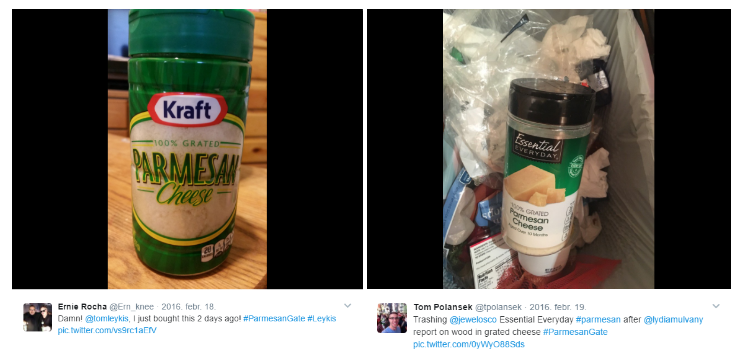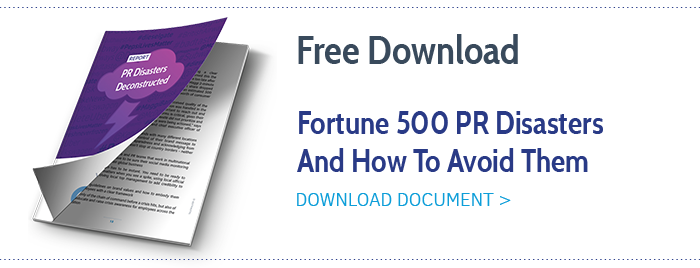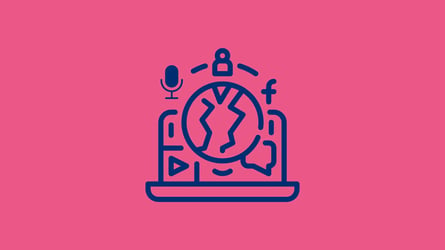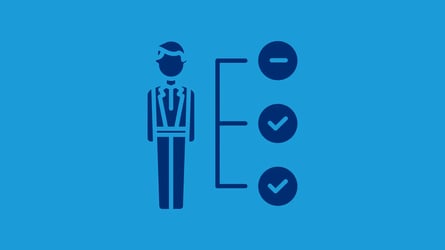In this article, we’ll present 5 risks brands have to be aware of in the era of fake news, along with concrete examples from brands such as Kraft Foods, Kellogg's or Amazon and a checklist to help your brand prepare for these scenarios.
What are the dangers of fake news for brands?
Pharma, luxury, professional services, energy, FMCG… No matter your industry, the fake news phenomenon should not be taken lightly. You may be spending millions on carefully crafting your image through PR efforts, brand content and widespread advertising campaigns, but at the end of the day, the consumer has never had so much effect on defining brands and products.
Here are a few fake news scenarios you should be aware of:
- An attack on your brand’s reputation – fake news about your brand is buzzing on the Internet
- An error in communication – you have unknowingly spread fake news through your channels
- The nature of your brand’s advertisement – because of one of your communications, the consumer doubts your brand’s values or honesty
- The location of your brand’s advertisement – you have advertised on a website perceived by some as fake news
- An error in critical assessment – you’ve based an internal decision on fake news
Start monitoring your brand reputation
Fake news about your brand: Wood chips in your Kraft parmesan cheese?
In the age of social media, consumers are the ones that control the perception of your brand, as several businesses had to find that out the hard way at the beginning of 2017. In London for example, an Indian restaurant almost had to close down after a fake news article falsely reported it had been caught using human meat spread like wildfire on the Internet.
The “wood in your parmesan” scandal is another case where a piece of news amplified by social media led to consumers questioning the honesty of several brands such as Kraft Foods. It all started with the publication of a report stating that “100 percent parmesan” could contain several percents of cellulose, a filler that can also be found in wood pulp.
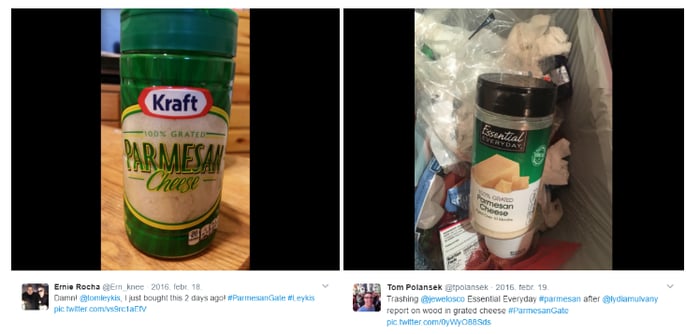
In a matter of days, the social outrage kicked in. At first, it was because the brands selling “100 percent parmesan” were perceived as having lied to the public as to what they were eating, thus putting in question the brand's honesty. Then in some media the wood pulp filler became wood chips, or even plain wood, and the story spread on social like wildfire, earning its very own hashtag #ParmesanGate.
It’s interesting to analyze the different types of reactions displayed by the public on social, as described in the visual below. Some were very factual and stuck with the original findings of the FDA report, while other clearly aimed to shock the online community.
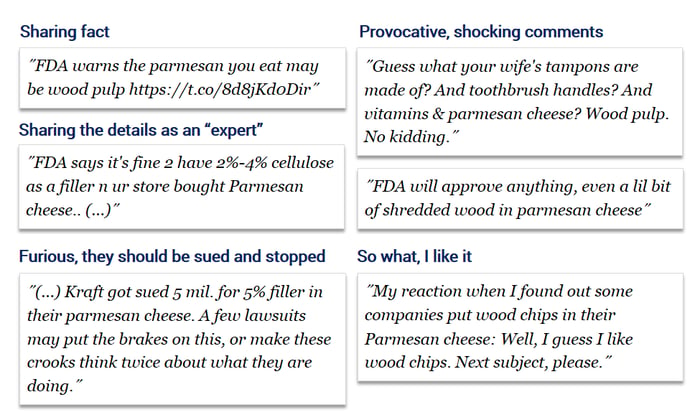
Source: Study from the social listening agency Bakamo Social
Advertising on a fake news website: when Amazon and Kellogg's are on Breitbart News
The fake news designation has also been applied to entire websites or media organizations. In the era of social media, the line between hyper-partisan media such as Breitbart News and patently fake information has become blurred, and such publications tend to be a red flag for consumers from the other side of the political spectrum.
This is exactly what happened to Amazon. Through the mechanics of online advertising, the e-commerce platform ended up being displayed on Breitbart News. The online movement Sleeping giants, which describes its purpose as "trying to stop racist and sexist media by stopping its ad dollars", took to Twitter to shame the brand (as well as other advertisers) for its “support” of the publication through its very wide network of supporters. And don't think you'll not get in trouble if you're a smaller company: these digital activists mean business, and now have local chapters for several countries, from France to Australia.
@chicagotribune are you aware that your ads appear on hate site breitbart? Please blacklist. @slpng_giants will help, then let us know pic.twitter.com/3fIwfbDU6l
— Mike Magrath (@micmagrath) 10 octobre 2017
If you come under such attack, carefully consider your options. In November 2016, cereal brand Kellogg's decided to withdraw its ads from Breitbart but then had to deal with the ire from the news site who started a #DumpKelloggs campaign in retaliation.
Fake news received or communicated by your brand
With the rise of clone sites of trusted media sources, it is easy to get tricked by what we feel might be a legitimate story, either on the brand channels or the personal accounts of the company’s top representatives. This poses a real threat for brands, as over 59 percent of consumers will stop purchasing products or services if a brand they love shared fake news with them.
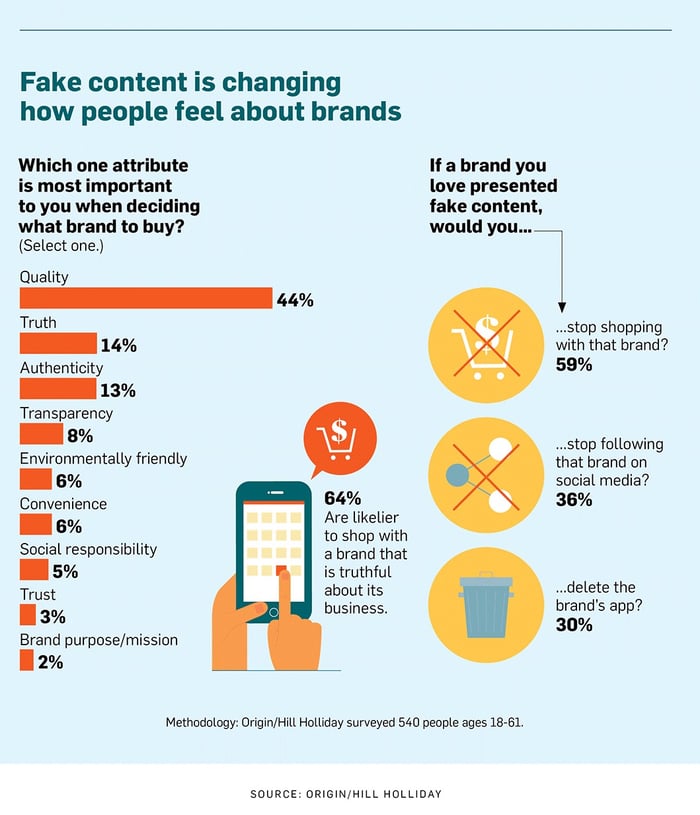
Brands should also be critical when presented with information on social: even media sites have been tricked (or hacked) into spreading fake information. Remember that time in 2013 when the AP Twitter account was hacked by Syrian activists who tweeted that the then President of the United States Barack Obama had been injured in an explosion at the White House? According to researchers, the hack ended up costing over $139 billion to stock market investors.
The GAFA giants are also feeling the fake news burn: telecom brand Vodafone, who owns one of the world's biggest advertising budgets, has threatened Facebook and Google to cut down on its investments in the platforms' ad if they could not protect brands from extremist and fake news materials.
Fake News: A Checklist for Your Brand
Here’s what you should remember: you don’t have to do anything wrong for fake news to be spread about your brand. The level of knowledge of consumers is usually low, and their reactions are based on unpredictable factors. Once they hear a piece of information, they’ll turn to social media to seek confirmation as well as to find out how it could impact them and their environment.
This is the interesting aspect of fake news: the original piece of news might not be fake at first, as it was the case for #ParmesanGate, but the way it is treated can blow it out of proportion and transform the nature of the information.
Remember, in the end, fake news are just another form of crisis, and just like for any other crisis, you need have two elements in place to keep its repercussions under (relative) control: (1) an alert-system that will allow you to detect the early signals of the crisis and (2) a detailed strategy to handle each category of scenario. In this mindset, here’s a checklist that will help you prepare:
- Monitor your brand reputation and your industry on the web and on social
- Identify early on the topics that can spur a reaction from the public
- Speak the emotional language consumers tend to favor on social
- Be authentic & build a relationship with your audience
- Check in detail the information you receive and share on social
- Be aware, as much as possible, of the nature of the websites where your brand is being advertised
If you want to know how to efficiently monitor what’s being said in real-time about your brand on social media, have a chat with one of our social listening consultants.

